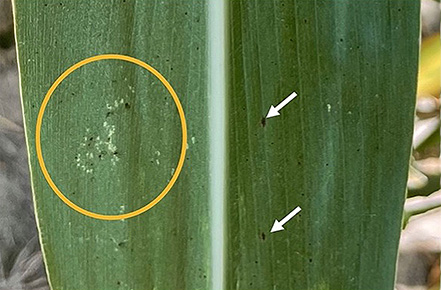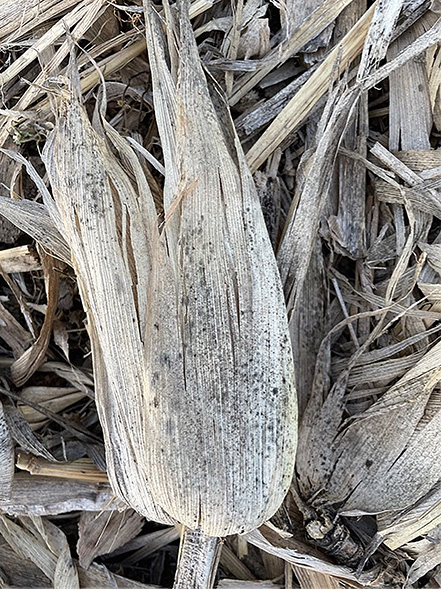Tar spot is a corn disease that was first confirmed in the United States in 2015 and detected in Missouri in 2019. The disease is caused by a fungus, Phyllachora maydis, which can survive Missouri winters, allowing it to persist from season to season. The impact of tar spot varies each year and is dependent on weather conditions, hybrid susceptibility, and timing of disease onset. Tar spot can be observed without subsequent yield losses. However, severe outbreaks can occur when conditions favor disease spread and result in significant yield losses of 20 to 60 bushel/acre in the north central United States1.

Tar spot identification




Infected plants produce small black raised spots that are visible on the leaves, sheaths or husks of corn (Figure 1A). These spots, called stromata, are fungal structures that cannot be scraped off the leaf surface. Stromata may be surrounded by tan or brown halos called “fisheye” lesions (Figure 1B). Stromata can be present on both sides of the leaves and on healthy green and senescing (dying) brown tissues. These lesions can appear throughout the season from corn in vegetative growth stage through corn senescence.
Tar Spot may be confused with:
- Insect frass (or insect poop)
Small black spots on leaf surfaces can resemble tar spot (gold circle on Figure 2). Look for:- Insect chew marks or other indicators of insect activity.
- Black specks that can be rubbed off the leaf. (Sometimes wetting the leaf is required)
- Saprophytic fungi
Evidence of these fungi are often observed in dried brown leaves and husks at harvest (Figure 3). Look for:- Smokey black lesions that can resemble tar spot.
- Lesions that are flat and not raised.
- Physoderma brown spot
This common disease of corn is caused by a fungal pathogen and has dark lesions in the midvein that cannot be rubbed away (Figure 4). Look for:- Dark, embedded lesions in the leaf midvein.
- Lighter, brownish lesions on leaf surfaces.
- Dark lesions can also appear on the stalk.
- Southern rust telia and teliospores
This disease can result in tiny black spores being produced near the end of the growing season. (Figure 5). Look for:- Light-orange to reddish colored pustules found predominately on the upper leaf surface.
- Tiny, black teliospores mainly found on the upper leaf surface.
Tar spot management
Corn fields should be routinely scouted for the disease to optimize fungicide applications. Focus scouting efforts during late vegetative and early reproductive growth stages.
Fungicides
The Crop Protection Network provides fungicide efficacy tables for tar spot and other corn diseases that are updated annually. Several currently available products can reduce tar spot severity in severe outbreaks2. Products with multiple modes of action have shown to decrease disease severity more so than products with a single mode of action2. Products with multiple modes of action and extended residual activity have most consistently protected yield in research studies across environments with varying levels of disease pressure2.
Fungicide applications have been most effective when timed between the VT/R1 (Tassel/Silking) and the R3 (milk) growth stages and shortly after tar spot symptoms appear on the ear leaf or above if conditions favor disease spread. No benefits of a fungicide application after the R4 (late dough into dent) growth stage have been observed.
Hybrid resistance
Corn hybrids differ in tolerance to tar spot. Growers should consult their seed dealers for the latest information on variety sensitivity. Farmers should combine tolerant corn varieties with fungicide applications for optimal control of tar spot and yield protection.
Cultural practices
Crop rotation and other practices that reduce corn residue can decrease the amount of fungal inoculum present in the field. These practices should not be considered complete solutions as spores can be moved from field to field by wind.
Disease life cycle and favorable disease conditions
The fungus that causes tar spot, Phyllachora maydis, can survive Missouri winters, allowing spores to persist throughout the year. Spores can be released from the lesions (stromata) by rain or high humidity and then are free to be dispersed by rain splashes or wind.
Infection is favored by extended periods of cooler air temperatures between 64°F and 73°F3. As the growing season progresses, extended periods of leaf wetness and increased moisture can promote disease spread. Consequently, irrigated fields are at an increased risk.
While various grass species can be infected by other Phyllachora species, corn and closely-related relatives are the only known hosts for Phyllachora maydis.
Additional resources
The MU Plant Diagnostic Clinic is available to assist with proper identification of the disease.
The Crop Protection Network has several resources for more in-depth information on tar spot:
- An Overview of Tar Spot (2020) CPN-2012, doi. org/10.31274/cpn-20190620-008
- Tar Spot of Corn Map (2025) Early Detection & Distribution Mapping System, University of Georgia
- Crop Disease Forecasting (2025) Crop Protection Network
- Corn Fungicide ROI Calculator (2025) Crop Protection Network
References
1Telenko D, Chilvers M, Kleczewski N, Mueller D, Plewa D, Robertson A, Smith D, Sisson A, Tenuta A, Wise K (2021) Tar Spot of Corn Web Book. Crop Protection Network.
2Goodnight M, Telenko D, Ross T, Chilvers M, Allen T, Ames K, Byrne A, Check J, Jay W, Mueller B, da Silva C, Roggenkamp E, Shim S, Smith D, Tenuta A, Thompson N (2024) Multi-state Fungicide Efficacy Trials to Manage Tar Spot and Improve Economic Returns in Corn in the United States and Canada. Crop Protection Network Publication CPN_5015, doi.org/10.31274/cpn-20240904-0.
3Webseter W, Nicolli C, Allen T, Bish M, Bissonnette K, Check J, Chilvers M, Duffeck M, Luis J, Mueller B, Paul P, Price P, Robertson A, Ross T, Schmidt C, Schmidt R, Schmidt T, Shim S, Telenko D, Wise K, Smith D (2023) Tar Spot Prediction in Corn: The Weather Matters. Crop Protection Network Publication CPN-5012, doi.org/10.31274/cpn-20231220-1.